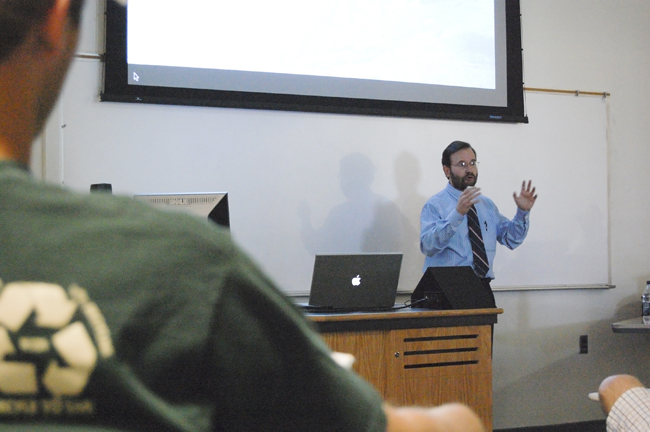USU professor documents Yellowstone revegetation
In 1988, John Ellsworth was on a faculty retreat in Yellowstone National Park. It was only a month after the most destructive fire season in park history had finally put itself out. Between team-building exercises and fly fishing for brook trout, Ellsworth photographed the charred landscape around him. A year later Ellsworth returned, this time with the sole intention of catching fish. The striking regrowth surprised him and he thought, “Wouldn’t it be neat to have a catalog to document the revegetation here?” He drove the 300 miles back to Logan, organized his slides from the year before and returned to Yellowstone to take repeat photos.
The initial curiosity turned into a 20-year passion. Yesterday at noon Ellsworth showed some of his photos and asked the question, is ecosystem recovery the same as scenery recovery and can you protect the environment and facilitate access for the public? Because this project wasn’t planned, the fifty odd photo sites represented what struck Ellsworth as particularly scenic or noteworthy and therefor represent an often underestimated natural resource aesthetic appeal scenery.
First Ellsworth established the details of the 1988 burn. When a thunderstorm started the fires mid-summer there was 7percent humidity and 70 mph winds. By the end of the season, 36 percent of Yellowstone National Park had gone up in flames. The burns of that year consumed 45 times more forest than any other year on record.
“The images of Yellowstone burning caused international controversy. People were asking, ‘why are they letting this iconic area burn’?” Ellsworth said. What had initially been a naturally ignited prescribed burn was completely out of anyone’s hands. Nothing but a severe September snow storm could stop the flames.
There have been hundreds of studies since then on the reestablishment of Lodgepole Pine, and how the fire affected wildlife but Ellsworth’s angle was distinct. He wanted to know how the fire changed the value of the scenery.
“Scenery is in the ‘eye of the beholder.’ This is the biggest lie ever perpetrated on people. We agree in many cases what is beautiful. If scenery were arbitrary and capricious and random, you land managers would be out of a job.” With this belief that beauty can be quantified, that it’s not completely ambiguous or subjective, Ellsworth set out to measure the viability of scenery in the park.
“Most people who visit Yellowstone see it from their car. The only thing that can get them out is a bathroom,”he said.
Ellsworth defined the areas of the park visible from a vehicle as the viewshed. The viewshed is the most sensitive area to scenery disturbances.
“When a fire burns we know it burns up some of the trees and critters but does it also burn the scenery? When does the area become scenic again?”
Using photoshopped images of the same scene with different extents of burn, Ellsworth conducted a survey to see how people considered fire on a scenic level. He found a 10 percent burn increased scenery preference. People liked the variety and the “mosaic pattern” left by the fire.
“You could see the landscape, you could see the animals, ” he said.
Different areas rehabilitate scenically at different rates. Within a year most meadows and even shrubland holds the same appeal while on some steep slopes three or four decades are needed. Considering the scenic value of an area changes management.
“If there’s a highly scenic area that needs to burn for its ecological health how long will it take to become scenic again?” If it’s a quick rebounding area “Torching it might not be a bad idea,” he said.
Ellsworth will be presenting his findings at the International Association for Wildland Fire coference entitled “Yellowston and Beyond” in Jackson Hole ,Wy next week.
–ben.abbott@aggiemail.usu.edu

